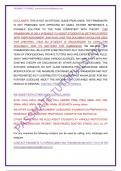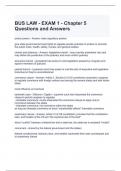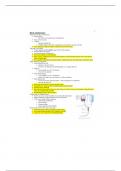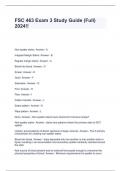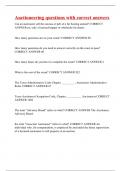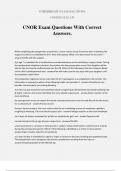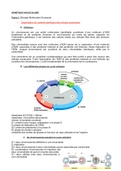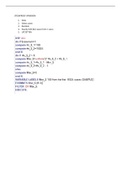PASSMATE TUTORIALS
DISCLAIMER: THIS IS NOT AN OFFICIAL GUIDE FROM UNISA. THE FRAMEWORK
IS NOT PREPARED NOR APPROVED BY UNISA, RATHER REPRESENTS A
POSSIBLE SOLUTION TO THE TASK CONSISTENT WITH THEORY. THIS
FRAMEWORK IS ONLY INTENDED TO ASSIST STUDENTS IN GETTING STARTED
WITH THEIR ASSIGNMENT, AND IN NO CASE THIS DOCUMENT SHOULD BE USED
FOR CHEATING, THUS NO STUDENT IS ENCOURAGED TO COPY THIS
DOCUMENT, NOR ITS SECTIONS FOR SUBMISSION. WE BELIEVE THE
FRAMEWORK WILL BE A GOOD STARTING POINT AS IT WAS PREPARED BY OUR
TEAM OF PROFESSIONAL PRIVATE TUTORS WHO ARE EXPERTS IN THE FIELD,
AND IT WAS PREPARED USING VARIOUS SOURCES. ANY SIMILARITY WITH ANY
EXISTING THEORY OR DISCUSSION BY OTHER AUTHORS IS EXCUSED. THE
AUTHORS HOWEVER DO NOT CLAIM MONOPOLY TO KNOWLEDGE HENCE
MODIFICATION OF THE ANSWERS CONTAINED IN THIS FRAMEWORK MAY NOT
BE PROHIBITED AS IT CONTRIBUTES TO EXPANSION OF KNOWLEDGE. FOR ANY
FURTHER GUIDELINE ABOUT THE INFORMATION CONTAINED HERE AND THE
MODULE IN GENERAL, CONTACT PASSMATE TUTORIALS.
WE ASSIST WITH OTHER MODULES INCLUDING:
ECSs, FACs, MACs, MNGs, INTs, TRLs, HMEMS, PRMs, PROs, MNBs, DSC, QMI,
MNMs, MNO, MNPs, FIN, PUBs, MNMs, RESEARCH among others.
WE OFFER CLASSES, ASSIGNMENT GUIDELINES, EXAMINATION PREPARATION,
RESEARCH AND RESEARCH PROPOSALS, DISSERTATION EDITING etc.
OTHER THAN UNISA, WE ALSO ASSIST STUDENTS AT VARIOUS INSTITUTIONS
INCLUDING MANCOSA, REGENT, REGEYNESES, BOSTON, STADIO, OLG, UJ, UP
etc
For any enquiries the following numbers can be used for calling, sms, whatsapp and
telegram
CONTACT PASSMATE TUTORIALS @061 262 1185/068 053 8213/0717 513 144 OR
email
,PASSMATE TUTORIALS
CONTACT PASSMATE TUTORIALS @061 262 1185/068 053 8213/0717 513 144 OR
email
PASSMATE TUTORIALS 061 262 1185/068 053 8213/0717 513 144
,PASSMATE TUTORIALS
Which of the following is correct regarding a pure monopoly?
a Monopolies are efficient.
b. Monopolies are state-owned.
c. Monopolies can be price-discriminating.
d. Demand is the same as the marginal revenue.
Question text
A monopolist has equated marginal revenue to zero. The firm has:
a. maximised revenue.
b. minimised profit
c. maximised profit.
d. minimised cost.
Question text
Which of the following statements about a monopolistic competitor is FALSE?
a. A monopolistic competitor will produce at an output level where its MR and SMC curves
intersect, given that it would make either a profit or a loss, which is less than its total fixed
cost.
b. The monopolistic competitor’s supply curve is part of its marginal cost curve.
c. The demand curve of a monopolistic competitor and that of its competitors may all have
different positions.
d. The demand curve of a monopolistic competitor is downward sloping.
Question text
Which is NOT true of state-owned and managed natural monopolies?
a. The wise state government will set price equal to average total cost (ATC) so that
losses will not have to be borne by the taxpayer.
b. Bureaucrats frequently maximise the operating budgets of their departments rather than
function with a profit-maximisation objective.
c. X-inefficiency is common because the incentives for profit are missing.
d. The state is better able to price at marginal cost (MC) because it can use its taxing
power to cover the losses that result from the MC pricing.
Which of the following statements is incorrect about a firm operating in a perfectly
competitive market?
PASSMATE TUTORIALS 061 262 1185/068 053 8213/0717 513 144
, PASSMATE TUTORIALS
a. A price higher than the marginal cost is charged.
b. The demand schedule is perfectly elastic.
c. There is no government intervention.
d. The firm is a price taker.
Question text
A natural monopoly is typically characterised by …
a. low fixed costs (FC) but very high variable costs (VC).
b. increasing average costs (AC), which makes it hard for new entrants to enter the
industry.
c. highly elastic product demand curves.
d. marginal costs (MC) that are lower than AC for large quantities of output.
Question text
Which of the following is correct regarding a firm operating in an oligopolistic market?
a. A cartel is generally illegal.
b. The firm has imperfect information.
c. The firm is a utility minimiser.
d. The firm demand is the same as its average revenue.
Question text
A firm faces the following average revenue (demand) curve:
P = 120 – 0.02Q
where Q is weekly production and P is price, measured in cents per unit. The firm’s
cost function is given by C = 60Q + 25,000. Assume that the firm maximizes profits.
What is the level of production?
a. 750
b. 6000
c. 1500
d. 3000
Question text
A monopolist in a glass making market appoints you as a pricing strategist and wants to
know how many glass products should the company produce and what price should the
company charge in order to maximise profit. The demand, marginal revenue and marginal
costs curves of the company are as follows:
Demand: P=10-Q
MR=10-2Q
MC=2.5+0.5Q
What price should the company charge to maximise its profit?
a. 3
b. 5
c. 8
d. 7
Question text
PASSMATE TUTORIALS 061 262 1185/068 053 8213/0717 513 144
DISCLAIMER: THIS IS NOT AN OFFICIAL GUIDE FROM UNISA. THE FRAMEWORK
IS NOT PREPARED NOR APPROVED BY UNISA, RATHER REPRESENTS A
POSSIBLE SOLUTION TO THE TASK CONSISTENT WITH THEORY. THIS
FRAMEWORK IS ONLY INTENDED TO ASSIST STUDENTS IN GETTING STARTED
WITH THEIR ASSIGNMENT, AND IN NO CASE THIS DOCUMENT SHOULD BE USED
FOR CHEATING, THUS NO STUDENT IS ENCOURAGED TO COPY THIS
DOCUMENT, NOR ITS SECTIONS FOR SUBMISSION. WE BELIEVE THE
FRAMEWORK WILL BE A GOOD STARTING POINT AS IT WAS PREPARED BY OUR
TEAM OF PROFESSIONAL PRIVATE TUTORS WHO ARE EXPERTS IN THE FIELD,
AND IT WAS PREPARED USING VARIOUS SOURCES. ANY SIMILARITY WITH ANY
EXISTING THEORY OR DISCUSSION BY OTHER AUTHORS IS EXCUSED. THE
AUTHORS HOWEVER DO NOT CLAIM MONOPOLY TO KNOWLEDGE HENCE
MODIFICATION OF THE ANSWERS CONTAINED IN THIS FRAMEWORK MAY NOT
BE PROHIBITED AS IT CONTRIBUTES TO EXPANSION OF KNOWLEDGE. FOR ANY
FURTHER GUIDELINE ABOUT THE INFORMATION CONTAINED HERE AND THE
MODULE IN GENERAL, CONTACT PASSMATE TUTORIALS.
WE ASSIST WITH OTHER MODULES INCLUDING:
ECSs, FACs, MACs, MNGs, INTs, TRLs, HMEMS, PRMs, PROs, MNBs, DSC, QMI,
MNMs, MNO, MNPs, FIN, PUBs, MNMs, RESEARCH among others.
WE OFFER CLASSES, ASSIGNMENT GUIDELINES, EXAMINATION PREPARATION,
RESEARCH AND RESEARCH PROPOSALS, DISSERTATION EDITING etc.
OTHER THAN UNISA, WE ALSO ASSIST STUDENTS AT VARIOUS INSTITUTIONS
INCLUDING MANCOSA, REGENT, REGEYNESES, BOSTON, STADIO, OLG, UJ, UP
etc
For any enquiries the following numbers can be used for calling, sms, whatsapp and
telegram
CONTACT PASSMATE TUTORIALS @061 262 1185/068 053 8213/0717 513 144 OR
,PASSMATE TUTORIALS
CONTACT PASSMATE TUTORIALS @061 262 1185/068 053 8213/0717 513 144 OR
PASSMATE TUTORIALS 061 262 1185/068 053 8213/0717 513 144
,PASSMATE TUTORIALS
Which of the following is correct regarding a pure monopoly?
a Monopolies are efficient.
b. Monopolies are state-owned.
c. Monopolies can be price-discriminating.
d. Demand is the same as the marginal revenue.
Question text
A monopolist has equated marginal revenue to zero. The firm has:
a. maximised revenue.
b. minimised profit
c. maximised profit.
d. minimised cost.
Question text
Which of the following statements about a monopolistic competitor is FALSE?
a. A monopolistic competitor will produce at an output level where its MR and SMC curves
intersect, given that it would make either a profit or a loss, which is less than its total fixed
cost.
b. The monopolistic competitor’s supply curve is part of its marginal cost curve.
c. The demand curve of a monopolistic competitor and that of its competitors may all have
different positions.
d. The demand curve of a monopolistic competitor is downward sloping.
Question text
Which is NOT true of state-owned and managed natural monopolies?
a. The wise state government will set price equal to average total cost (ATC) so that
losses will not have to be borne by the taxpayer.
b. Bureaucrats frequently maximise the operating budgets of their departments rather than
function with a profit-maximisation objective.
c. X-inefficiency is common because the incentives for profit are missing.
d. The state is better able to price at marginal cost (MC) because it can use its taxing
power to cover the losses that result from the MC pricing.
Which of the following statements is incorrect about a firm operating in a perfectly
competitive market?
PASSMATE TUTORIALS 061 262 1185/068 053 8213/0717 513 144
, PASSMATE TUTORIALS
a. A price higher than the marginal cost is charged.
b. The demand schedule is perfectly elastic.
c. There is no government intervention.
d. The firm is a price taker.
Question text
A natural monopoly is typically characterised by …
a. low fixed costs (FC) but very high variable costs (VC).
b. increasing average costs (AC), which makes it hard for new entrants to enter the
industry.
c. highly elastic product demand curves.
d. marginal costs (MC) that are lower than AC for large quantities of output.
Question text
Which of the following is correct regarding a firm operating in an oligopolistic market?
a. A cartel is generally illegal.
b. The firm has imperfect information.
c. The firm is a utility minimiser.
d. The firm demand is the same as its average revenue.
Question text
A firm faces the following average revenue (demand) curve:
P = 120 – 0.02Q
where Q is weekly production and P is price, measured in cents per unit. The firm’s
cost function is given by C = 60Q + 25,000. Assume that the firm maximizes profits.
What is the level of production?
a. 750
b. 6000
c. 1500
d. 3000
Question text
A monopolist in a glass making market appoints you as a pricing strategist and wants to
know how many glass products should the company produce and what price should the
company charge in order to maximise profit. The demand, marginal revenue and marginal
costs curves of the company are as follows:
Demand: P=10-Q
MR=10-2Q
MC=2.5+0.5Q
What price should the company charge to maximise its profit?
a. 3
b. 5
c. 8
d. 7
Question text
PASSMATE TUTORIALS 061 262 1185/068 053 8213/0717 513 144



